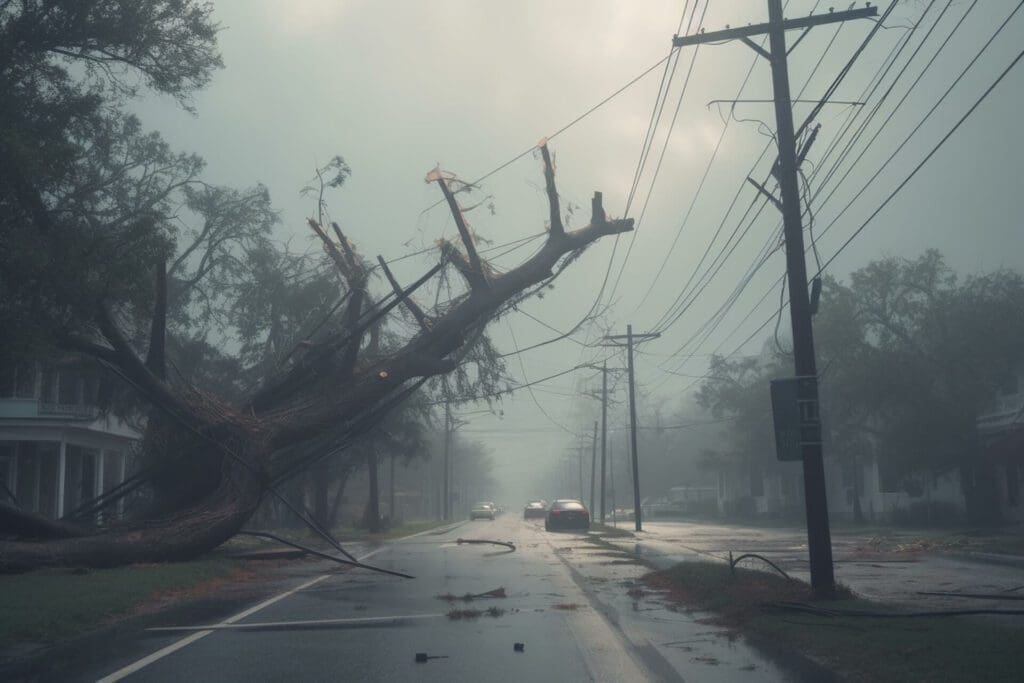One of the shipping industry’s most detrimental setbacks is unpredictable and disruptive weather. Extreme weather can wreak havoc on a business resulting in numerous delays, lost/damaged goods, and an elevation in prices. Solely in 2005, the US suffered economic losses amounting to $200 USD billion. With the potential for so much monetary loss, proper preparedness in disaster logistics is essential.
A Brief Overview of the Main Challenges Faced in Logistics During Natural Disasters
In the worst-case scenarios, natural disasters and extreme weather can destroy entire communities, wreaking havoc on shipping industries that may have relied on these communities to stay afloat. To avoid running into the same challenges that have taken down the shipping industry in the past, it is important to understand the main challenges natural disasters and extreme weather bring to every separate sector of the shipping business and how to overcome these weather-related logistics challenges.
Understanding the Impact of Natural Disasters on Logistics
1. Hurricanes
Since much of the shipping industry relies on overseas transportation, hurricanes can affect shipping on a global scale. Even if only one area is affected by a hurricane, shipping can be globally affected because it can cause infrastructure such as ports or freights to become damaged, which can result in severe delays in the shipment of goods. This could even resort in prices skyrocketing as the amount of freights or goods is reduced.
2. Floods
Floods can also cause major disruptions at shipping ports due to the damage they can inflict on the port as well as on the freights that are available for shipping. If weather conditions prove to be unsafe or damage has been incurred at the port, goods may have to spend a significant amount of time waiting at the port for weather conditions to clear, causing them to depreciate over time.
3. Earthquakes
Infrastructure destruction is often a major result of Earthquakes. In areas suffering from Earthquake damage, bridges may be out, roads can be left damaged for significant amounts of time, and shipping vessels can be left destroyed or damaged. All this infrastructure damage can lead to rising costs in products, as well as severe delays in shipping time while the area gets repaired.
4. Wildfires
Wildfires are becoming more frequent and more destructive each year, wreaking havoc on the shipping industry. Wildfires cause poor air quality, which often leads to highway closures. With highways closed and the air quality dangerous, shipments become delayed as they wait for the highways to open up and the air quality to improve.
The Potential Consequences of Natural Disasters on Logistics Operations
1. Timeline disruptions
Although extreme weather can potentially cause serious delays to shipments, customers do not see it this way. Over the years, the expectation for how quickly a shipment should arrive has actually increased significantly, so even if extreme weather does hit, which is inevitable, this does not deter customers from expecting their shipment at their door on time. Therefore, shipping companies have to be creative in finding ways to work around extreme weather conditions to not delay the delivery of their shipments.
2. Infrastructure damage
Natural disasters are inevitably going to cause infrastructure damage, whether it be to shipping vessels, highways, bridges, buildings, ports, runways, or other vital equipment. With these infrastructure damages, delays become more probable, as well as added costs for repairs and the depreciation of goods as delays in shipping occur.
3. Inventory management challenges
Rising costs tend to be a huge challenge while navigating inventory management before and after a natural disaster. Natural disasters, on average, cost the shipping industry 3.5 million dollars in damages every year. Despite supply chain management devoting a lot of time and effort to strategizing yearly organized budget plans, natural disasters can often create unexpected and unprecedented changes in budget plans. Even if supply plan management calculated loss due to natural disasters, there is never a precise estimate of how much loss a company can truly suffer due to a natural disaster.
4. Transportation and distribution issues
Whether it be a flood, tornado, or major snowstorm, when disaster strikes, the number of shipping vessels will lower exponentially. Unsafe weather conditions do not permit shipping vessels to safely transport their goods even if the area they are transporting them to is not experiencing unsafe weather. In addition, some inclement weather can even trap shipping vessels in place for days, leading to less availability of these vessels.
Conducting a Risk Assessment in Logistics Disaster Preparedness
Importance of Risk Assessment in Disaster Preparedness
Natural disasters are inevitable; every year, they occur, and every year, they wreak havoc on the shipping industry. However, the best way for you and your team to combat the unpredictable is by being thoroughly prepared for every worst-case scenario. By identifying your risk assessment, you are identifying every potential outcome that could occur and how your team is planning to handle it.
Identifying the Potential Risks Specific to Your Location
- Researching historical weather data – History can tell you a lot about past weather trends. If you are handling business in the south, prepare for hurricane season in the fall. Whereas if you are in the west, you will want to create a backup route in case of highway closures due to wildfires.
- Understanding local vulnerabilities – The sooner you know which natural disasters tend to hit which areas, the better you will be able to create alternative plans in case of disaster.
Assessing the Impact on Logistics Operations
- Analyze supply chain vulnerabilities – It is best to know your weaknesses as a supply chain before disaster strikes.
Developing a Comprehensive Disaster Response Plan
Establishing an Emergency Response team
- Roles, responsibilities, and communication protocols – Every member of your team should be designated with certain roles and responsibilities in case of emergency. Devise a disaster plan ahead of time and communicate clearly who on your team will hold which roles.
Creating a Communication Plan
- Internal communication channels – Within your team, complete honesty is a priority. Every one of your team members should be prepared to candidly lay out any changes in the transportation process.
- External communication with partners and stakeholders – Be prepared to speak to partners and stakeholders regularly. It is important to also establish trust with them so that they can be updated about any detrimental changes in plans or delays.
Building a Business Continuity Plan
- Identifying alternative suppliers and transportation routes – Even if risk is low, it is essential to have a backup plan. Your backup plan should include alternate suppliers and transportation routes in case of emergency.
Implementing Safety Measures for Employees and Facilities
- Evacuation procedures – Disaster can strike while on the job; therefore, it is important that your team is aware of all emergency protocols. Make sure your team devises evacuation procedures for every trip and has proper emergency training and access to all emergency supplies and equipment.
Strengthening Infrastructure and Supply Chain Resilience
Reducing Dependency on Single-Source Suppliers
- Building relationships with alternative suppliers – Never rely on a single supplier. If that supplier suffers damage due to a disaster, then you also suffer from an inability to supply. Having an alternate supplier reduces the risk of you being unable to supply in the state of an emergency.
Leveraging Technology for Disaster Preparedness
Implementing a Robust Inventory Management System
- Inventory tracking and visibility – Ensure that you always know where your shipment is with the proper tracking technology. This way, even if shipping gets delayed, you’ll know where your items are.
Utilizing Real-Time Data and Analytics
- Monitoring weather conditions – Before a shipment and during a shipment, keep track of the weather in order to be prepared if extreme weather is approaching. You might be able to thwart certain weather systems or disasters before they impact your shipping this way.
Exploring Automation and Robotics in Logistics Operations
- Enhancing efficiency and agility – Be prepared to learn and utilize automation and robotics to increase efficiency and lessen your dependency on human error or inability to complete a task.
Training and Educating Employees
Conducting Regular Training Sessions on Disaster Preparedness
- Safety protocols and evacuation drills – It is not enough to simply have emergency and safety protocols in place — your team should also be aware of how to put them into practice. Requiring regular drills and training can prevent uncertainty in the event of a real emergency.
Storm Equipped Shipping Trucks
If unprepared, a disaster can mean ruin for a business, bringing added importance to finding innovative solutions to combat even the most extreme weather. At Next Exit Logistics, we are prepared to tackle the most difficult shipments, abiding by strict timelines and ensuring the utmost safety of all goods, even when disaster strikes. That is why we hope to offer you our helpful strategies and feedback to ensure that your team is prepared for the next disaster. To learn more about our equipment, contact us today.
FAQs
How Can Logistics Companies Mitigate Supply Chain Disruptions Caused By Natural Disasters?
Logistics companies should also devise alternate routes and form a relationship with an alternate supplier to decrease disruptions caused by natural disasters.
What Are Some Key Steps to Develop an Effective Emergency Response Plan for Logistics Operations During Extreme Weather Events?
Every shipping company should keep clear and honest communication with all members of their team as well as their partners/stakeholders. Additionally, every team should devise an emergency evacuation plan as well as have an alternative shipping route lined up.




